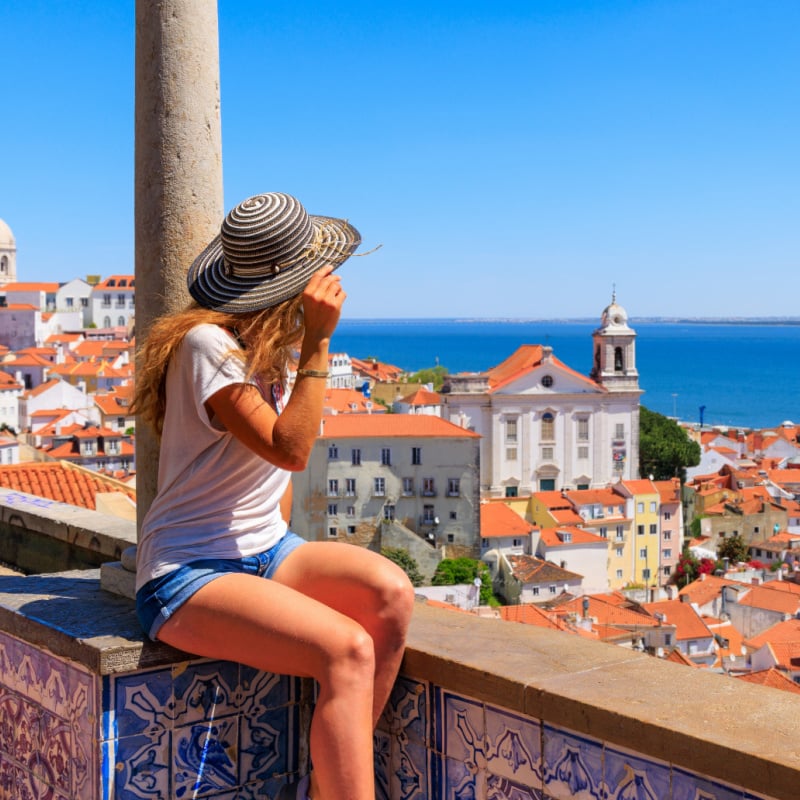Share the article
Last updated
Portugal isn’t the first destination that comes to mind when you mix words like ‘sun’ and ‘culture’ – at least for the average American – especially when there are countries like Spain, it’s much bigger neighbour, Italy or Greece to consider .
It is much smallerit does not have a Mediterranean coastline – Portugal straddles the North Atlantic – and as a country it is smaller than most US states.

Still, it has gained immense popularity among Americans, especially in the post-pandemic scene, but why?
Given Portugal’s extensive list of hidden gems not yet overrun by tourists, beautiful beaches and high affordability, it really comes as no surprise that it has become so trendy:
Why do tourists flock to Portugal?
Portugal, one of Europe’s oldest and most traditional nations, occupies the westernmost part of the Iberian Peninsula, which is also shared by Spain, and a small part of France.

It is the westernmost state in Europe, and while it has always been a popular sunny getaway for Europeans, until recently it was largely ignored by travelers from across the pond.
With border restrictions lifted and tourism restored, Americans are eager to travel where their compatriots have not yet trodand despite Portugal being a summer hot spot, it remains a lesser-known destination among US visitors.
When making transatlantic travel, a majority of Americans use London, Dublin or German hubs as access points, with England and Ireland in particular often ranking as the most searched destinations. This is largely due to the strong historical ties between the US and the British Isles.
Top 5 travel insurance plans for 2023 from $10 per week

This is changing fast.
More Americans are choosing Portugal for their international travel
A record number of Americans have already taken a trip to Portugal this year, inspired by its beautiful Atlantic beaches, warm weather, cultural richness and lower consumer prices.
The country’s capital, charming and hilly Lisbon, is an ancient marvel that ranks among the wonders of Western Europe oldest settlements and a maze of cobbled streets with colorful Iberian-style buildings leading to a large fortress.
The typical European cityscape.

Lisbon is also one seriously underrated destination for foodiesas tourists strolling through the lively Belém district, where the famous “pastéis de nata” were first prepared, as well as several other Portuguese delicacies, will quickly learn.
Portugal Beyond Lisbon
Beyond Lisbon, whether heading north or south, tourists are greeted with breathtaking views of a dramatic Atlantic coastline fringed by golden sand and bordered by an azure, troubled sea.
Because it’s not the Mediterranean, it can feel a lot colder to swimmersbut no doubt it’s still refreshing during Portugal’s scorching late summer and early autumn weather, when temperatures easily climb above 25°C.

Surfers are especially drawn to Nazaré, when towering waves that seem to come from the sky crash against the shoreline, while swimmers prefer the quieter pools in southern Portugal’s Algarve, home to more than 100 swim-friendly beaches , or the quaint seaside town of Lagos.
Traveling north instead, you’ll find enchanting Porto (Portuguese for “Harbor”), the country’s number two metropolitan area and arguably the most exciting city triphome to several colorful Iberian churches, quirky street corner bars and picturesque cobbled streets where trams run through.
A Portuguese Venice And Ancient Roman Temples

Other incredible Portuguese hidden gems not to be missed include Aveiro, a city criss-crossed by canals, known as the Portuguese Venice, and Évora, which is perhaps home to the Temple of Diana. the best preserved Roman-era pagan temple in Portugal.
Huge tourist offerings aside, Portugal is shockingly cheap compared to its European counterparts, which is especially intriguing given that it’s the westernmost state in Europe, and Western Europe is generally more expensive than the East.
On average, you should budget between $43 and $81 per day on a trip to Lisbon, based on data collected by The smart backpackeror even less if you are really frugal and don’t eat out every night in more expensive restaurants.

According to crowdsourced Numbeothe estimated monthly expenses of a single person are about $756, not including accommodation, and Lisbon is up to 31.7% cheaper than Paris, with meals in low-cost restaurants costing just $13 on average.
When it comes to hotels, BudgetYourTrip states that the average nightly rate is $109 for a single room in central Lisbon, based on data collected from more than 1,691 accommodation providers.
Tourists can find accommodation for much cheaper than thateven when staying in youth hostels or a family-owned guest house, with rates for the former starting at just $23 for a dorm room this fall.

Portugal is a great off-season destination
Portugal is so affordable that it was recently voted the best country in the world for digital nomads in Europe, due to its low cost of living, without necessarily translating into a lower quality of life or limited availability of services, its excellent weather – Lisbon for example enjoys an average of 300 sunny days per year – and a wide range of attractions.
Although it is not such a popular destination in America, Portugal is well connected to the United States via several non-stop flight routes, connecting both Lisbon and Porto, the main international hubs, to cities such as New York/Newark, Miami, Boston and others for just $533 one way for upcoming dates.
Outside mainland Portugal, the autonomous archipelagos of the Azores, known as European Hawaii, and Madeira, off the coast of West Africa, also offer direct flights to and from the US east coast.
Traveler warning: Don’t forget travel insurance for your next trip!

SUBSCRIBE TO OUR LATEST MESSAGES
Enter your email address to subscribe to receive the latest travel news from Travel Off Path, delivered straight to your inbox.
This article originally appeared on TravelOffPath.com




